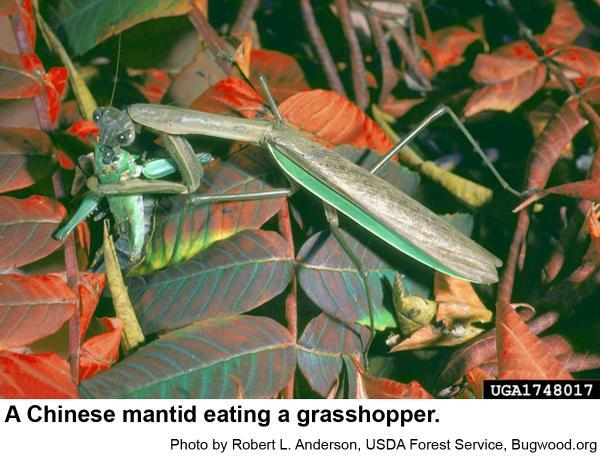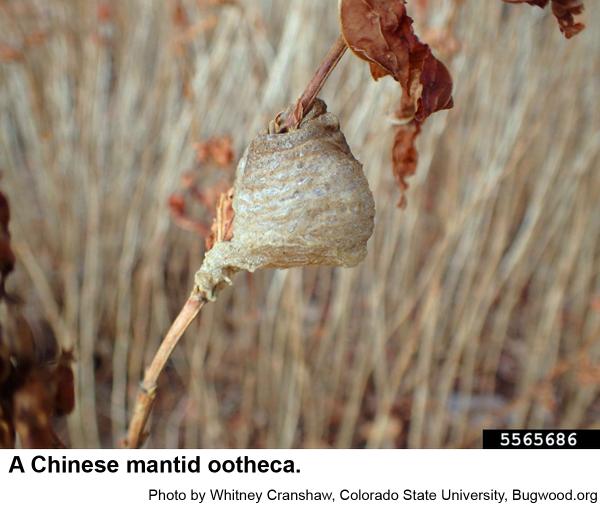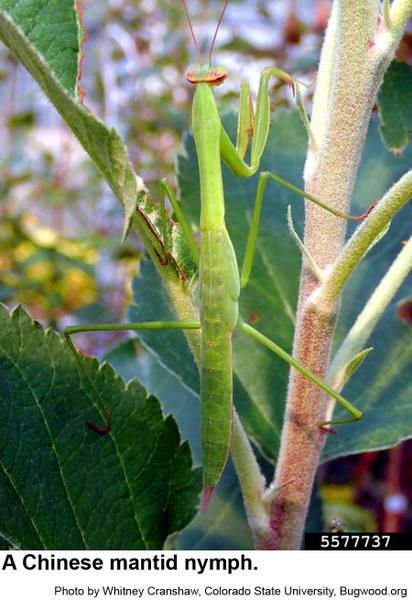Description and Biology
The Chinese praying mantid, Tenodera sinensis, is a slender, brown or green insect 3 inches (males) to 4 3⁄8 inches (females) long. The fore legs are adapted for grasping prey and are often held against the thorax in a "praying" position. The head is triangular with very slender antennae and prominent eyes. The Chinese mantid can swivel its head 180 degrees. Wings are held flat over the abdomen when not in flight. Females are flightless. Toward the end of their lives, females find a suitable stem and lay 50 to 600 eggs in a frothy mass that hardens around the eggs (the ootheca) that protects the eggs over winter. In spring, tiny nymphs hatch and sometimes dangle down from the ootheca in a small mass. Their soft integument soon hardens, and they disperse to find tiny insects upon which to feed. Nymphs molt six or seven times as they grow. Nymphs resemble smaller versions of adults, but lack wings (although older nymphs have noticeable wing buds).
Prey
Chinese mantids feed on just about any animal they can subdue including butterflies, cockroaches, crickets, flies, grasshoppers, moths, and spiders. They have even been photographed feeding on humming birds! On the other hand, Chinese mantids are themselves fed upon by larger birds, reptiles, and insectivorous mammals.
Residential Recommendations
Chinese mantid oothecae are sold as biological controls. If one purchases an ootheca, it is best to refrigerate it or keep it outdoors during the winter. A problem with bringing these egg masses indoors is that warm indoor temperatures cause the eggs to hatch prematurely, and the house is soon crawling with tiny praying mantids at a time of year that is very difficult to find insects to feed them. They then start to eat each other. It is a fascinating thing to feed a cricket or other small insect to a mantid. If kept in captivity, they need to be fed frequently and provided with a source of water. Websites that give directions for the care of mantids as pets are plentiful.
Other Resources
- Bird Predation By Praying Mantises: A Global Perspective. Nyffeler, M. M. R. Maxwell, and J. V. Remsen. 2017. The Wilson J. of Ornithology, 129(2):331-344.
- Caring for a mantis. Anonymous. 2019. Keeping Insects, Caring for a praying mantis, butterflies, stick insects and beetles.
- Chinese Praying Mantis – Biology, Diet, Distribution, Lifespan, Growth, Cannibalism, and its Predatory Behavior. Waleed. No Date. Praying-Mantis.org
- Praying Mantises Hunt Down Birds Worldwide. Nyffeler, M. 2017. University of Basel.
- Extension Plant Pathology Publications and Factsheets
- Horticultural Science Publications
For assistance with a specific problem, contact your local N.C. Cooperative Extension center.
This Factsheet has not been peer reviewed.
Publication date: April 13, 2019
Reviewed/Revised: Oct. 26, 2019
N.C. Cooperative Extension prohibits discrimination and harassment regardless of age, color, disability, family and marital status, gender identity, national origin, political beliefs, race, religion, sex (including pregnancy), sexual orientation and veteran status.



